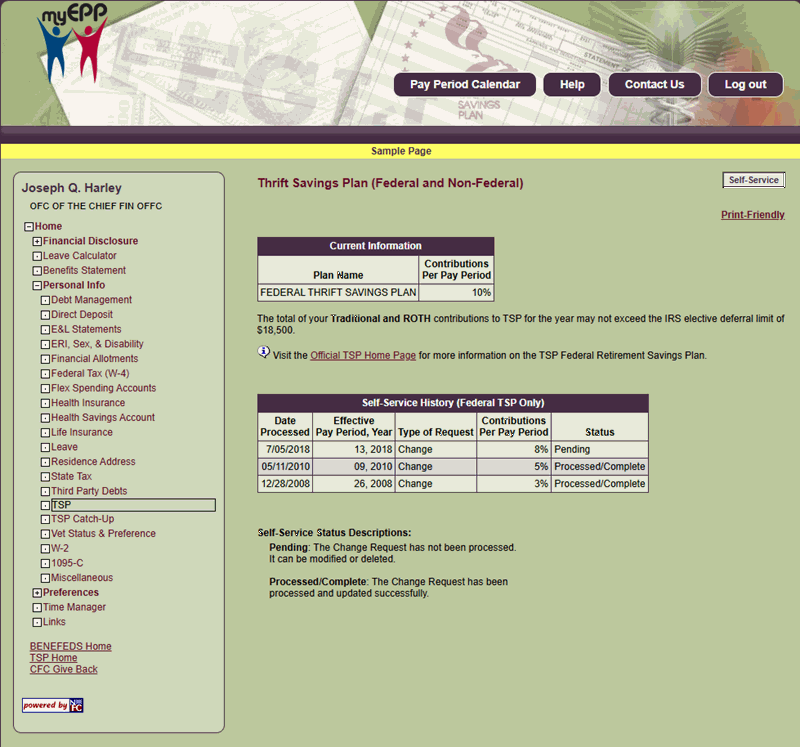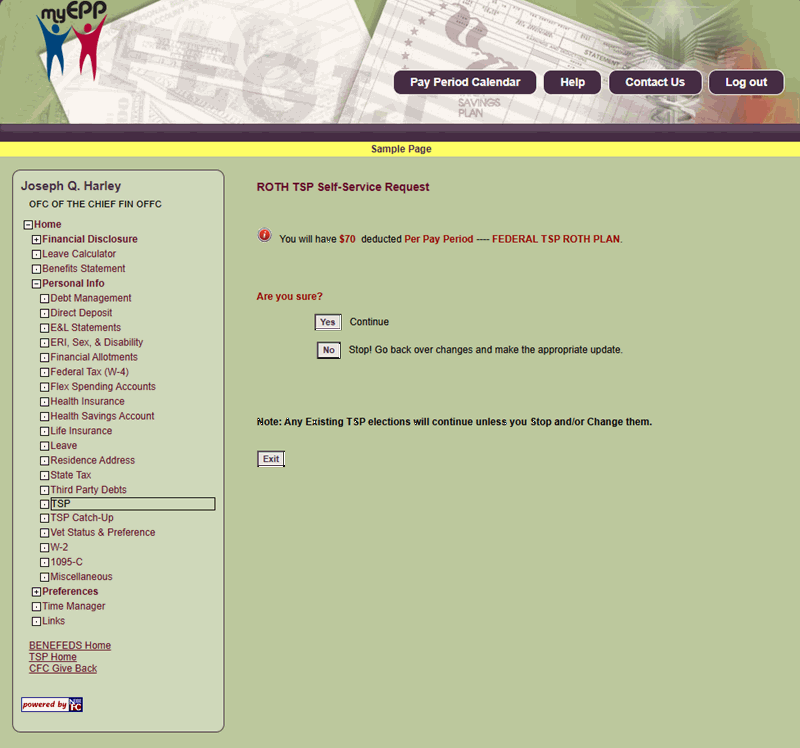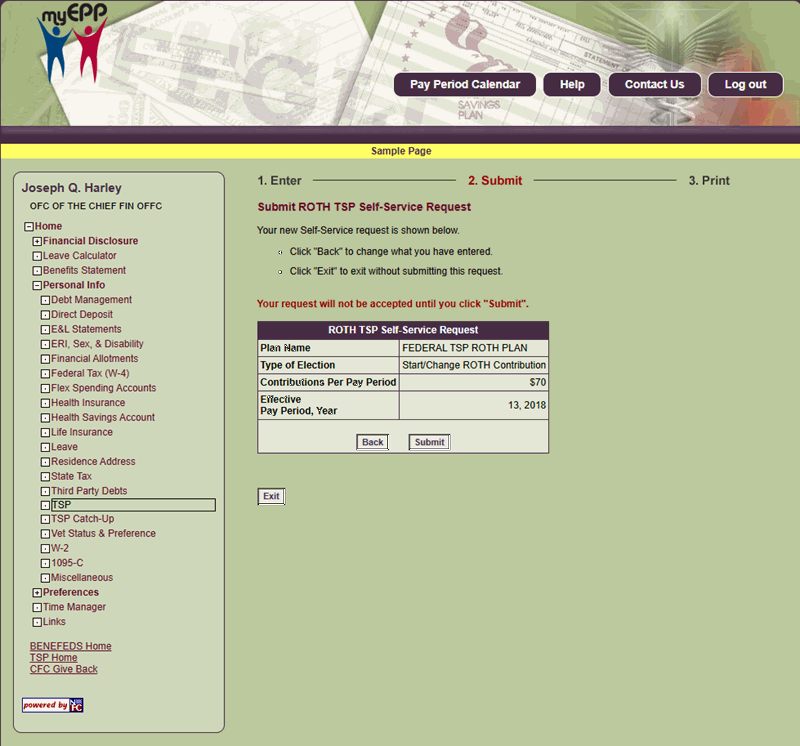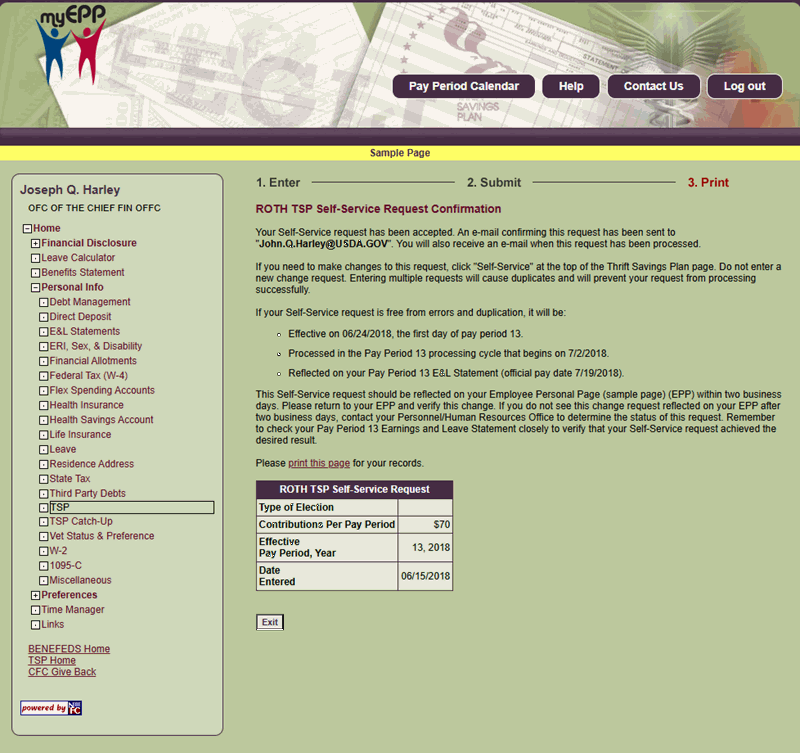Thrift Savings Plan (TSP)
The TSP menu option allows users to view their current TSP data. Users can also start, stop, or change TSP contributions.
TSP is a retirement savings and investment plan for Federal employees covered by the Federal Employees Retirement System (FERS) and the Civil Service Retirement System (CSRS).
TSP provides retirement income for participants and offers Federal employees the same type of savings and tax benefits that many private corporations offer their employees under 401(k) plans.
The Thrift Savings Plan Enhancement Act of 2009, Public Law 111-31, signed on June 22, 2009, authorized the Federal Retirement Thrift Investment Board (FRTIB) to add a Roth 401(k) feature to the plan. This benefit allows participants to contribute on an after-tax basis to their TSP accounts and receive tax-free earnings when they withdraw funds (assuming certain criteria are met). For more information on Roth requirements, see the TSP website at https://www.tsp.gov.
TSP contributions are voluntary in the amount chosen by the participant. TSP benefits are in addition to employees’ FERS or CSRS annuity. TSP is an important part of a FERS employee’s retirement package, along with their FERS Basic Annuity and Social Security benefits. For CSRS employees, TSP serves as a supplement to their CSRS annuity. For more information about TSP, see the TSP Web site at https://www.tsp.gov.
- To make changes to TSP, select the TSP component. The Thrift Savings Plan (Federal and Non-Federal) page is displayed. The user’s existing TSP data that is stored in the Payroll/Personnel System as of the last effective pay period is displayed.

Figure 112: Thrift Savings Plan (Federal and Non-Federal) Page
- Select the Self-Service button. The TSP Self-Service Request page is displayed.

Figure 113: TSP Self-Service Request Page
-
Select the Start TSP ROTH Contribution button for Roth transactions. The Enter ROTH TSP Self-Service Request page is displayed.

Figure 142: Enter ROTH TSP Self-Service Request Page
OR
Make the applicable selection on the Pending Self-Self Requests box for TSP transactions.
- Complete the TSP and/or ROTH fields as follows:
Type of Election Field Instruction
Dollar Amount Field Instruction
Percent of Basic Pay Field Instruction
Effective Pay Period, Year Field Instruction
-
Select the Continue button. The ROTH TSP Self-Service Request page is displayed.

Figure 115: ROTH TSP Self-Service Request Page
OR
Select the Exit button to cancel the action. The Submit ROTH TSP Self-Service Request page is displayed.

Figure 116: Submit ROTH TSP Self-Service Request Page
-
Select the Submit button to submit the changes entered. The TSP Self-Service Request Confirmation page is displayed.

Figure 117: ROTH TSP Self-Service Request Confirmation Page
OR
Select the Back button to return to the Enter TSP Self-Service Request page.
OR
Select the Exit button to cancel the action. The Thrift Savings Plan (Federal and Non-Federal) page is displayed.
-
Select the Exit button. The Thrift Savings Plan (Federal and Non-Federal) page is displayed.

Figure 118: Thrift Savings Plan (Federal and Non-Federal) Page
TSP Catch-Up Contributions
TSP catch-up contributions were supplemental tax-deferred employee contributions that employees could make to TSP beyond the maximum amount they could contribute through regular contributions.
Note: In Fall 2024, TSP will send a one-time notice to eligible participants turning age 60–63 in calendar year 2025. The employee's date of birth must be accurate in the National Finance Center (NFC) system to ensure eligibility for higher catch-up contribution limits, with no opt-in required.
Note: As of Pay Period 26, 2020, catch-up contributions are no longer available, and all TSP contributions should be made in the same manner (including any spillover contributions above the maximum annual contribution amount). Any previous catch-up contributions submitted are still visible via EPP.
TSP Spillover Contributions
Spillover contributions are made in conjunction with regular TSP contributions. There is no special form for spillover contributions.
To be eligible to make spillover contributions, the following conditions must apply:
- The employee must be at least age 50 years or older during the calendar year in which the spillover contributions are made (even if the employee becomes age 50 on December 31 of that year).
- The employee must be currently employed and in a pay status (contributions are made through payroll deductions).
- The employee must be making regular contributions to a civilian or uniformed services TSP account (or both) and/or an equivalent employer plan (401(k) 403(b), or 408 plan) that equals the maximum allowed by IRS.
Eligible employees may contribute up to the annual maximum dollar amount allowed by the IRS elective deferral limit.
Since spillover contributions are supplemental, they do not count against the IRS elective deferral limit. However, the combination of regular and spillover TSP contributions cannot exceed the total IRS contribution limit for the year.
Contributions spilling over toward the catch-up limit will be matched, but only up to the 5% of salary to which participants are already entitled.
Spillover contributions apply to the year during which they are made, even if they are posted to the TSP account in the following year (e.g., employee contributions for the last pay date in December may not be posted until January, but will be counted toward the limit in December).
Spillover contributions may only be made from the employee’s basic pay. Bonuses or special pay and incentive pay for members of the uniformed services, cannot be applied towards spillover contributions.